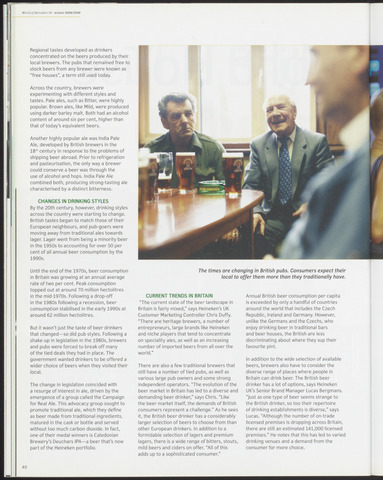World of Heineken 39 winter 2008/2009
Regional tastes developed as drinkers
concentrated on the beers produced by their
local brewers. The pubs that remained free to
stock beers from any brewer were known as
"free houses", a term still used today.
Across the country, brewers were
experimenting with different styles and
tastes. Pale ales, such as Bitter, were highly
popular. Brown ales, like Mild, were produced
using darker barley malt. Both had an alcohol
content of around six percent, higher than
that of today's equivalent beers.
Another highly popular ale was India Pale
Ale, developed by British brewers in the
18th century in response to the problems of
shipping beer abroad. Prior to refrigeration
and pasteurisation, the only way a brewer
could conserve a beer was through the
use of alcohol and hops. India Pale Ale
combined both, producing strong-tasting ale
characterised by a distinct bitterness.
CHANGES IN DRINKING STYLES
By the 20th century, however, drinking styles
across the country were starting to change.
British tastes began to match those of their
European neighbours, and pub-goers were
moving away from traditional ales towards
lager. Lager went from being a minority beer
in the 1950s to accounting for over 50 per
cent of all annual beer consumption by the
1990s.
Until the end of the 1970s, beer consumption
in Britain was growing at an annual average
rate of two per cent. Peak consumption
topped out at around 70 million hectolitres
in the mid-1970s. Following a drop-off
in the 1980s following a recession, beer
consumption stabilised in the early 1990s at
around 62 million hectolitres.
But it wasn't just the taste of beer drinkers
that changed—so did pub styles. Following a
shake-up in legislation in the 1980s, brewers
and pubs were forced to break off many
of the tied deals they had in place. The
government wanted drinkers to be offered a
wider choice of beers when they visited their
local.
The change in legislation coincided with
a resurge of interest in ale, driven by the
emergence of a group called the Campaign
for Real Ale. This advocacy group sought to
promote traditional ale, which they define
as beer made from traditional ingredients,
matured in the cask or bottle and served
without too much carbon dioxide. In fact,
one of their medal winners is Caledonian
Brewery's Deuchars IPA—a beer that's now
part of the Heineken portfolio.
There are also a few traditional brewers that
still have a number of tied pubs, as well as
various large pub owners and some strong
independent operators. "The evolution of the
beer market in Britain has led to a diverse and
demanding beer drinker," says Chris. "Like
the beer market itself, the demands of British
consumers represent a challenge." As he sees
it, the British beer drinker has a considerably
larger selection of beers to choose from than
other European drinkers. In addition to a
formidable selection of lagers and premium
lagers, there is a wide range of bitters, stouts,
mild beers and ciders on offer. "All of this
adds up to a sophisticated consumer."
In addition to the wide selection of available
beers, brewers also have to consider the
diverse range of places where people in
Britain can drink beer. The British beer
drinker has a lot of options, says Heineken
UK's Senior Brand Manager Lucas Bergmans.
"Just as one type of beer seems strange to
the British drinker, so too their repertoire
of drinking establishments is diverse," says
Lucas. "Although the number of on-trade
licensed premises is dropping across Britain,
there are still an estimated 141,000 licensed
premises." He notes that this has led to varied
drinking venues and a demand from the
consumer for more choice.
The times are changing in British pubs. Consumers expect their
local to offer them more than they traditionally have.
CURRENT TRENDS IN BRITAIN
"The current state of the beer landscape in
Britain is fairly mixed," says Heineken's UK
Customer Marketing Controller Chris Duffy.
"There are heritage brewers, a number of
entrepreneurs, large brands like Heineken
and niche players that tend to concentrate
on speciality ales, as well as an increasing
number of imported beers from all over the
world."
Annual British beer consumption per capita
is exceeded by only a handful of countries
around the world that includes the Czech
Republic, Ireland and Germany. However,
unlike the Germans and the Czechs, who
enjoy drinking beer in traditional bars
and beer houses, the British are less
discriminating about where they sup their
favourite pint.
40

